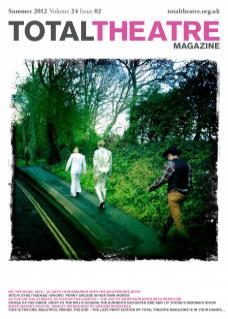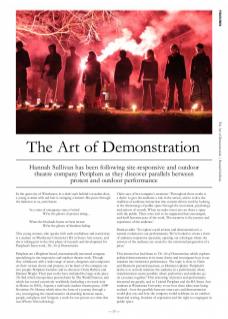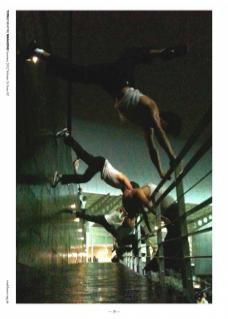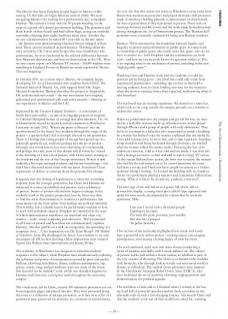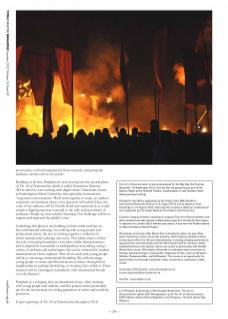In the quiet city of Winchester, in a dark vault behind a wooden door, a young woman with red hair is swinging a lantern. She peers through the darkness at us, and chants:
In a state of emergency state of mind
We’re the ghosts of protest rising…
When the blockade burns we beat retreat
We’re the ghosts of freedom hiding
This young woman, who speaks with such confidence and conviction, is a student on Winchester University’s BA in Street Arts course, and she is taking part in the first phase of research and development for Periplum’s latest work, The Art of Demonstration.
Periplum are a Brighton-based, internationally renowned company specialising in site-responsive and outdoor theatre work. Though they collaborate with a wide range of actors, designers and composers on their various shows and projects, at the heart of the company are two people: Periplum founders and co-directors Claire Raftery and Damian Wright. Their past works have included the large-scale piece The Bell, which incorporates pyrotechnics by The World Famous, and which has toured extensively worldwide (including a six-week stint in Mexico in 2010); Arquiem, a mid-scale outdoor theatre piece; 1,000 Revolutions Per Moment, which takes the form of a journey through a city, investigating the transformative relationship between music, people, and place; and Navigator, a work for one person at a time that uses iPhone film technology.
Claire says of her company’s creations: ‘Throughout these works is a desire to give the audience a role in the action, and to evolve the tradition of audience interaction into content-driven work by looking at the dramaturgy of public space through the movement, psychology and actions of crowds. When we make street arts we share a space with the public. Their voice isn’t to be suppressed but encouraged, and itself becomes part of the work. The narrative is the journey and experience of the audience.’
Damian adds: ‘To explore social actions and demonstration is a natural evolution in our performances. We’ve looked to create a form of audience-responsive spectacle, opening out a dialogue where the answers of the audience are crucial to the emotional progression of a piece.’
This interest has lead them to The Art of Demonstration, which explores political demonstration in its many forms and investigates how it can translate into immersive performance. The topic is close to Claire and Damian’s personal passions, as Damian explains: ‘Periplum’s desire is to actively immerse the audience in a performance where transformation seems possible; where performers and audience go on a journey together.’ This mirroring of protest and performance interested me greatly, and so I joined Periplum and the BA Street Arts students at Winchester University to see how these ideas were being realised – how the parallels between street arts and demonstration would play out; and how the company would celebrate, in an outdoor theatrical setting, freedom of expression and the right to congregate in public space.
The idea for this latest Periplum project began in Mexico (while touring The Bell with an Anglo-Mexican team in 2010). ‘We were navigating Mexico City looking for a performance site,’ remembers Damian. ‘We turned a corner and saw 50 people kneeling on the steps of a grand old colonial government building. The protesters had black hoods on their heads and held yellow flags, acting out symbolic surrender, claiming their rights had been taken away. Another day, we saw a demonstration by naked 60+ year-olds in the city centre – the farmers were demonstrating that they’d been stripped of their land. These actions bordered on performance. Thinking about the ways actions by UK Uncut and Occupy also cross borderlines into performance, we were fascinated by the cultural differences between how Mexicans demonstrate and how we demonstrate in the UK. Then we saw a news report on a Mexican TV station – 50,000 students were marching in England. Events in Britain are rarely reported in Mexico. This was inspiring.’
In October 2011, on a return trip to Mexico, the company began developing The Art of Demonstration with students from ENAT, The National School of Theatre Art, with support from The AngloMexican Foundation. Damian describes the project as ‘inspired by UK and international events – the way movements have erupted, galvanised and synchronised with each other recently – drawing on our experiences in Mexico and the UK’.
Supported by the Creative Campus Initiative – a consortium of South East universities – as one of its flagship projects in response to Cultural Olympiad themes of courage and determination, The Art of Demonstration moved its research and development to Winchester University in early 2012. ‘What’s the point in Protest?’ was the question posed by the Street Arts students through this stage of the project – a question that I feel is strongly relevant to my generation. There is a feeling that young people of my age have grown up in a politically apathetic era, and have perhaps lost the art of protest – although very recent history has seen something of a turnaround, and perhaps the early years of this decade will in future be viewed as the dawning of a new era of protest, with Green issues coming to the forefront and the rise of the Occupy movement. Protest is now suddenly a hot topic amongst students and twenty-somethings – one that I have discussed many times with my peers. Sometimes I hear expressions of defeat, or cynicism about the potential for change.
It appears that this feeling of hopelessness is often the overriding response from the younger generation, but Claire and Damian are interested in a sense of rebellion and passion, and a celebration of protest. Stories of protest old and new began to emerge in the students’ work as the project progressed, but the focus was then to find the art in demonstration; to construct a performance that concentrates on the form rather than inciting one political intention. This is tricky, but a valuable lesson for performance students in how to work with turbulent subjects. Periplum are interested in the ways in which demonstration manifestos are manifold and often very creative – sonic, visual, symbolic, and subversive. ‘We’re interested in all forms of protest and how ideas are communicated,’ explains Damian, ‘whether graffiti on a wall, an occupation, the spreading of a computer virus… A key inspiration was Dr. Gene Sharp’s 198 Methods of Nonviolent Action. We challenged the Street Arts students to try and encompass all 198 in their devising. Other inspirations were seminal figures like Welfare State International and Jeremy Deller.’
The residency at Winchester was designed to stimulate students’ responses to the subject, while Periplum were simultaneously exploring the influence and power of interpretation carried by press and media. Parkour, clowning, installation, drama, audience participation, rap, poetry, music, song, and pyrotechnics were just some of the forms that featured in the students’ work, which was threaded together by Damian and Clare into a trail piece sited throughout the university campus.
The visual team, led by Claire, created 100 miniature protesters cut-out from magazine pages and placed into jars. They were presented along the route as a collection of antique protesters, as if they were relics of a generation past, preserved for posterity. In a moment of synchronicity, the very day that this action was taken in Winchester, news came from Russia that anonymous protesters had placed miniature doll protesters made of small toys holding placards to demonstrate on their behalf, for fear of persecution if they’d protested in person. These sorts of meetings between real life events and the work made by students kept arising throughout the Art of Demonstration project. The ‘Russian doll’ protesters were eventually outlawed for being non-Russian residents.
Damian: ‘We’re interested in the borderline between legality and illegality in protest and performance in public space. It comes back to ownership of public space: who really owns this space, who do we have to answer to – both Periplum and the communities we work with – and how far can we push forms of expression within it. This is an ongoing issue in the mechanics of protest, including in the new “digital public space”.’
Watching Clare and Damian work with the students, I could see precious advice being given – the kind that could only come from experienced practitioners – including tips on how to deal with a moving audience, how to create holding activities for the moments when the show is running slower than expected, and knowing when to take breathers!
The trail itself was an exciting experience. We started on a mini-bus, which took us on a trip outside the campus grounds, on a mission to reclaim the streets.
When we pulled back into the campus and got off the bus, we were met by a kerfuffle of noise made up of broken news stories played through iPhones and a group of people with surly demeanour. They led us to a woman in a balaclava who summoned us inside a building. In a frantic but hushed voice the woman explained that the media lie. I was told to keep close, to move fast, and to sign a petition. Scuttling along corridors and being beckoned through doorways, we reached what the woman called ‘the media studio’. Enjoying the fun of an undercover mission, I did as I was told and ran inside. I was then left with a hostage sat tied to a chair and told to watch a large TV screen. As the screen flickered into action, the twist was revealed: the woman who had led the raid turned out to be a news presenter; the event had been a set-up, and I had now been caught on camera as a violent protester taking a hostage. As I exited the building with my hands in the air two performers playing a reporter and cameraman followed me asking, ‘What is it like to be an activist, a radical, a terrorist?’
The next step of the trail led us to a grassy hill where, after a pyrotechnic display, a young street poet called Caspa appeared and spoke his own words, accompanied by a drum beat by musician performer, Mike:
Last year I stood with a thousand people
Fighting to be equal
Put away the guns, put away your needles
But this was a prequel
To police brutality…
This section of the trail really highlighted how music and words have a powerful role within protest – inciting action, encouraging participation, and creating a lasting legacy of what has been.
The trail continued, and I next met three clowns conducting a series of marches and drills, with a mock-military air. The subject of protest works well within a clown routine, as rebellion is part of the very essence of clowning. The clown is a character who meddles with hierarchy, who through foolery reveals our structured world as bizarre, as ridiculous. The student clown-protesters were inspired by the Clandestine Insurgent Rebel Clown Army (CIRCA), who have reclaimed the art of anarchist clowning, staging protests and demonstrations for political agendas.
The trail drew a circle and so I finished where I started, at the bus, my head full of powerful speeches and my body overtaken by the adrenalin rush of such a fast-changing journey. Afterwards Claire said that the students’ work was all they could have asked for, ‘exciting, provocative, evolved imaginatively from research, and giving the audience various roles in the action’.
Building on all this, Periplum are now moving into the second phase of The Art of Demonstration, which is called Transmission. Damian: ‘We’re about to start working with digital artists VisuoSonic, based at Southampton Solent University, who specialise in interactive “responsive environments”. We’ll work together to create an outdoor responsive environment where a live spectacle will unfold. Here, the voice of the audience will be literally heard and represented, as soundsensitive digital projections respond to the calls and movements of audiences. People say that nobody’s listening. Our challenge will be to capture and represent the public’s voice.’
Underlying this phase is the building of both online and face-toface international exchange: by working with young people and professional artists, the aim is to bring together a collective in which international exchange can occur. This phase aims to reflect the role of crossing boundaries or borders within demonstrations, and is inspired by transmedia or multiplatform storytelling, using a variety of artforms and technologies that can be witnessed in modern demonstration. Claire explains: ‘Part of our work with young people will be to encourage international friendship. We will encourage young people to create and film interactive journeys through their neighbourhood, perhaps identifying, or crossing, lines within it. These journeys will be exchanged, transmitted, with international friends over the Internet.’
Periplum as a company have an educational focus, often working with young people and students, and this project seems particularly apt for the involvement of a rising generation of artists and would-be protesters.
Expect uprisings of The Art of Demonstration throughout 2012!
The Art of Demonstration is being developed for the Big Day Out Festival, Bracknell, 15 September 2012, and will also be appearing as part of the Mexico Week at the Nuffield Theatre, Southampton in late October (both dates pending funding).
Periplum’s The Bell is appearing as the finale of the 25th Stockton International Riverside Festival on 5 August 2012 and at Newbury Corn Exchange on 10 August 2012, featuring the company’s Mexican collaborators and supported by The Anglo-Mexican Foundation and Conaculta.
Creative Campus Initiative continues to support The Art of Demonstration and other professional-educational collaborative projects in the South East region in response to London 2012 themes and values. It has won the Podium award for Best Creative Cultural Project.
Winchester University’s BA Street Arts is headed by John Lee and offers expert teaching in basic street arts practice, whilst helping students further connections within the UK and internationally, including creating performance opportunities and internships with the Winchester Hat Fair, Britain’s oldest established street arts festival, which now works in partnership with the BA Street Arts course. Winchester University co-ordinates many excursions to Europe, and also brings in visiting UK companies of note, such as Periplum, Mimbre, Desperate Men, and Wildworks. The course is an opportunity for street artists to formulate a practice, make connections, and build a viable career.
University of Winchester: www.winchester.ac.uk course.enquiries@winchester.ac.uk
Hat Fair: www.hatfair.co.uk
